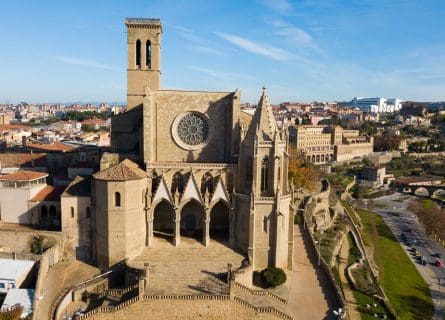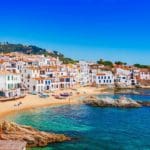Pla de Bages Wine Region Guide
Where Misty Valleys Meet Elevated Elegance, Just a Whisper from Barcelona
EXPLORE ALL OUR CATALUNYA WINE REGIONS GUIDE
Last updated: October 11, 2024
Introduction
Pla de Bages is well worth a day trip from Barcelona; small, dynamic, and perfectly formed. Its vineyards are centered around the town of Manresa, situated due north of Catalunya’s capital, where a close-knit community of winegrowers produce a wide range of delicious wine styles; traditional method sparkling, seductive rosé and fortified dessert wines are all up for grabs. There is plenty to tempt oenophiles looking for something a little less obvious and a little more esoteric: Pla de Bages old vine Picapoll is one of the unsung heroes of Catalan whites. But there is no shortage of excellent Chardonnay, too, for those who crave the comforting familiarity of an old friend.
Discover more about Spanish Wine
History

The city of Manresa is the gateway to Pla de Bages, an oasis of vines in Catalunya’s heartland. According to legend, a Roman settlement called Bacassis gave rise to the name Bages – Bacassis was supposedly created in honor of Bacchus, the Roman god of wine. Of course, this may be a charming myth: a fairytale to delight tourists. However, historians are confident that the Romans – led by the general Scipio – conquered the Iberian Peninsula in the 2nd century BC.
After founding the cities of Barcino (Barcelona) and Tarragona, the Romans went on to transform life in Catalunya, building roads, temples, amphitheaters, and aqueducts. Vines were planted in every fertile corner of the Catalan landscape – an era of peace and prosperity endured for over five centuries. Yet, in the 5th century AD, the Western Empire descended into chaos.
The catalyst for this implosion was a combination of Roman hubris and aggressive encroachment from rival powers. After sacking Rome in AD 410, the Visigoths settled in France briefly. However, the bellicose Franks pushed them into the Iberian Peninsula; the Ostrogoths, Vandals, and Seubi coveted Spain’s mineral wealth and valuable strategic position.
Eventually, the long-haired and comparatively Romanized Visigoths established a permanent base in Toledo in central Spain. But this isn’t the end of the story: an army of Berber and Arab mercenaries crossed into Andalucia in 711. The Moorish general Tariq led this well-equipped fighting force to conquer most of Spain within seven years; Catalunya became a defacto Muslim province in 718. In the eighth century, wine growing ceased to be an important part of daily life in Pla de Bages.
Yet by the 10th century, historical records suggest that viticulture had returned to the Llobregat Valley. This aligns with our knowledge of the early Middle Ages in Catalunya: Frankish knights pushed the Moors out of Barcelona in the early 800s. Meanwhile, Cistercian monks from northern Europe flocked to Spain, attracted by the growing cause of Christian reconquest. The monks produced some of Catalunya’s finest wines from their base at the Sant Benet de Bages monastery.
By 1492, the Catholic monarchs Fernando of Aragon and Isabel of Castile had retaken the last Muslim stronghold of Granada. A united nation spent the next hundred years colonizing Central and South America – much gold and silver flowed into the coffers of the Spanish state. Unfortunately, feckless Habsburg kings wasted much of this newfound wealth on endless wars with their European neighbors, while Spain remained a relatively backward country. By the late 17th century, a bankrupt monarchy looked increasingly desperate.
However, Catalunya enjoyed an economic revival in the 1800s, as new industries and trade with the Americas created an influential and highly prosperous middle class. Politically, though, Manresa’s seminal moment came in 1897: the city was the scene of the first assembly of the Unio Catalanista, which published a nationalist manifesto entitled ‘Bases de Manresa.’
Sadly, Franco’s victory at the end of the Spanish Civil War ended Catalan independence; regional freedoms were severely curtailed, and the language was banished from all institutions. Several decades earlier, the phylloxera louse had devastated winegrowing in Pla de Bages, attacking the vine roots with its poisonous bite. It would take over a century for the region to recover its confidence: Pla de Bages was awarded DO status in 1997.
Geography and terroir
Pla de Bages unveils a mesmerizing beauty in the fall: veils of mist enfold its valleys as vine growers nurture their crops. This hidden gem lies just 50 kilometers northwest of Barcelona, offering a serene escape from the bustling Catalan metropolis.
Most vineyards are on either side of the River Llobregat and its tributaries, flanked by towering mountains and hilltop monasteries. Today, over 25 different municipalities are entitled to use the designation’ DO Pla de Bages,’ many encircling Manresa. Splendid isolation is the word that comes to mind: this is one of Catalunya’s least densely populated regions. To the east is the up-and-coming DO Emporda; Priorat and Terra Alta are found southwest of Pla de Bages.
A Blend of Mediterranean and Continental Influences
Meanwhile, the local climate is a hybrid: Mediterranean and continental influences. Hot summers and cold winters are the standard, with about 550mm of annual rainfall. Yet diurnal temperature variation is a significant force for good in the region due to the abundance of high-elevation terroirs.
However, the appellation has two distinct subzones, and growing conditions can vary substantially. Vineyards planted in the central river basin enjoy a warmer mesoclimate, as the altitude is relatively low by Catalan standards (200 meters above sea level). Red grape varieties tend to do better here, cultivated on clay soils. But the Alt Bages (Upper Bages) is a whole different story: vineyards rise to over 500m in some places, with a concomitant higher level of diurnal temperature variation and more freshness in the wines. Calcareous soils are ideally suited to white varieties, particularly Chardonnay, Macabeo, and Picapoll.
Winemaking and regional classifications
Within Catalunya, Pla de Bages is widely associated with producing aromatic white wines – reliably crisp and fruity. The sommeliers’ favorite, of course, is Picapoll; old bush vines yield very complex and perfumed grapes, brimming with garrigue, citrus, and apricot notes. Moreover, even the best producers rarely charge the earth for these magnificent wines. Picapoll’s ability to maintain good acidity, even in the hot climate of rural Catalunya, is a major part of the attraction. For that reason, growers are planting more each year.
Sparkling wine is another growing niche in Pla de Bages. Vino de Aguja is a specialty of the DO: the term translates as ‘needle wine.’ But, as off-putting as that sounds, it only refers to the slight spritz on the tongue. This is achieved via carbonation or, more traditionally, bottling wine with a bit of remaining sugar and yeast. It does not resemble Cava in any way, as the level of carbon dioxide is minimal, and the traditional method is not used. However, ‘Vino Espumosos de Calidad’ are made in the same way as Champagne, produced in a sweet and dry style.
Niche Dessert Wines
They are high-quality alternatives to Cava and Corpinnat, although the volumes pale in comparison. That theme continues with the Vino Dulce Naturales and Vino Rancios. The former involves adding grape spirit to sun-dried grapes during fermentation; Vino Rancios are maderized in clear glass demijohns and left to bake in the Spanish sun. They closely resemble Madeira and are delicious with Crema Catalana. But Mistela (a mixture of grape must and spirit) is definitely an acquired taste. We’ve yet to acquire it.
Red wines, however, are very popular with both visitors and locals. Blending is a veritable art form in Pla de Bages: Cabernet Sauvignon/Tempranillo concoctions can electrify the palate, in addition to Bordeaux blends and Syrah/Cabernet wines. Top labels inevitably spend some time in new oak – preferably French. They share much in common with the red wines of Penedes: intense concentration and ripe tannins. They are also very affordable.
Facts & Figures
Key wine styles
- Aromatic white wines; full-bodied reds and rosés; sparkling wine;
Appellation structure
- DO Pla de Bages
Hectares under vine
- 600
Average annual production
- 5000 hectoliters per annum
Approximate number of wineries
- 16
The lowdown
It is an understatement to say that Pla de Bages is enjoying its moment in the sun. Although the total acreage is a pale shadow of the mid-19th century, the region has fully recovered from the phylloxera pandemic – and then some! Indeed, the post-Franco years witnessed the death of state monopolies – responsible for absolute dross- and the emergence of family-owned wineries. Their ethos and level of ambitions can vary significantly, albeit many are focused on exporting a greater volume of wine to key markets like the US and Hong Kong.
They have established their own winemaking styles and respective niches, with fresh and fruity whites being the obvious highlight. If there is one slightly regrettable development, it is that too many bodegas make wines acceptable to Western supermarkets from predictable grape varieties – “not another Merlot,” etc.
Rediscovery of Old Vine Picapoll
Nevertheless, the last 25 years have been revolutionary. Winemakers have invested capital and revenue into improving cellar equipment and increasing the area under vine. Yet, for many critics, the greatest gift to oenophiles is a long-established tradition: the seductive essences of old vine Picapoll. And so the focus of our discussion returns to esoteric flavors and original tastes – nectar of the gods for wine geeks and sommeliers. As far as they’re concerned, this is where the magic lies.
Key Grape Varietals
-
Chardonnay
Chardonnay is a green-skinned grape varietal native to the Burgundy wine region in France and one of the most popular varieties worldwide.
Find out more -
Gewurtraminer
Explore Gewurztraminer, a highly aromatic white grape from Alsace, France. Savor its unique character and allure in every sip
Find out more -
Macabeo (Viura)
Discover Viura: Rioja's Prominent White Grape & Catalonia's Macabeo. Explore its versatility in exquisite wines. A must-read for wine enthusiasts.
Find out more -
Picapoll Blanco
The Picapoll Blanco grape is a captivating indigenous white grape variety from Spain, renowned for its intriguing flavors, historical significance, and remarkable versatility. With its vibrant acidity, citrus and stone fruit notes, and herbaceous undertones, wines crafted from Picapoll Blanco offer a refreshing and crisp sensory experience.
-
Parellada
Unveil the allure of Parellada grape: a Spanish gem crafting elegant sparkling & white wines. Explore its unique qualities & flavor profile.
Find out more -
Sauvignon Blanc
The sauvignon blanc grape varietal, originally from the Bordeaux region of France, is now one of the world's most loved white varieties.
Find out more -
Cabernet Franc
Cabernet Franc grape is a close relative of Merlot and Cabernet Sauvignon and is the principal blending grape used in Bordeaux.
Find out more -
Cabernet Sauvignon
Discover the irresistible allure of Cabernet Sauvignon—a worldwide favorite with robust, dark-bodied flavor. Unleash your wine journey today!
Find out more -
Garnacha Tinta (Grenache Noir)
Garnacha: Spain's Red Gem. Akin to Pinot Noir, it bridges terroir and winemaking, crafting captivating expressions.
Find out more -
Merlot
Merlot is the most cultivated grape in Bordeaux and closely related to Cabernet Franc
Find out more -
Syrah
Syrah is dark-skinned and perhaps the most underrated of the 'noble' red grape varieties.
Find out more -
Sumoll
Sumoll, a rustic black grape native to Catalonia's Penedès region, yields red, white, rosé wines, and Cava. Once widespread in Spain, it faced a decline since the 1980s. Now revived, it offers distinctive wines valued by local winemakers and is renowned for its unique flavor profile of red berries, herbs, and earthy tones. Also known as Vijariego Negro, it features in the Canary Islands and Pla de Bages DOPs.
-
Tempranillo
Discover Tempranillo: Spain's iconic red grape. From Ribera del Duero to Toro, it yields concentrated wines. Explore its synonyms and unleash its prowess.
Find out more
Pla de Bages gastronomy
Gastronomes rave about northeastern Spain: Catalan food is among Europe’s best, and you’ll have plenty of opportunities to indulge your desires in the quieter parts of Catalunya. Hearty meat and game dishes are a staple of Pla de Bages and its environs; olla aranesa (a rich, filling stew) is served in almost every tavern in Manresa during the winter months. In the summer, however, even inland chefs will offer some delicious seafood, including langoustines, squid, and octopus.
Catalan Gastronomy Guide: Read now
Wineries Recommended by Cellar Tours
More information
If you would like us to customize an exclusive luxury tour, contact us and let us know your travel plans. We offer luxury food and wine tours for private groups of a mininium two guests. In addition, all of our private, chauffeured tours are available year-round upon request.



